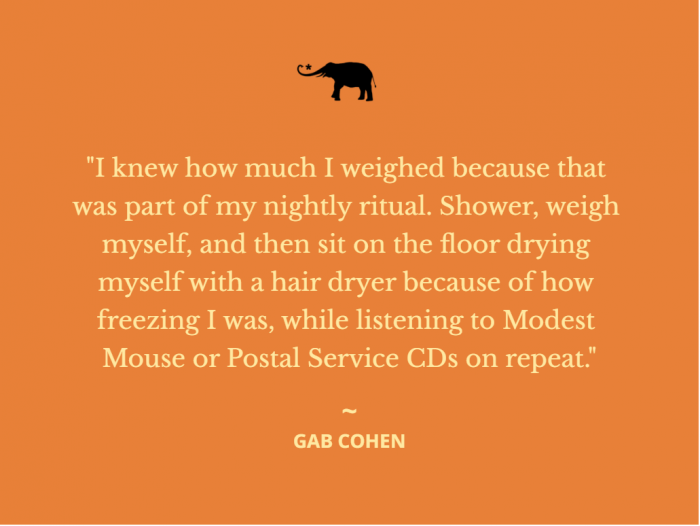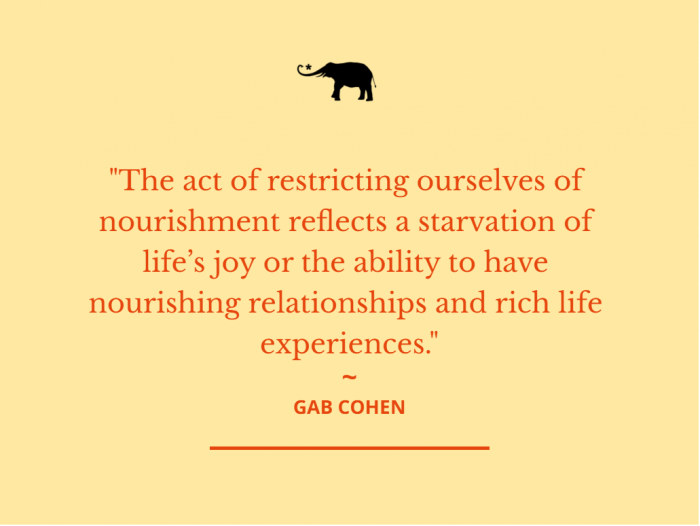“Gabrielle! What the hell!? Are you alright?” My mom screamed.
There I was, naked and emaciated as my mother howled in terror, picking me up off the shower floor like a bag of bones.
This was bad.
She wasn’t supposed to see how thin my body had become. For the months leading up to that moment of fainting in the shower, in my distorted perception, I had masked my anorexia and had it down to a science.
I would wear bulky sweaters and cover up my frail body. I would bring extra sweaters, socks, and hoodies to change into on weigh in days, which was once a week, usually on Thursdays. Those days were always nerve-wracking for me. Not only did I have to pack my school bag like I was going camping, but I also had to speed walk to the library where my mother would pick me up. Instead of using the computer on Thursdays like I usually would to browse LiveJournal or MySpace, I had to sneak downstairs to the children’s section and use the family-sized bathroom so I could get undressed and redressed with all my added layers.
I couldn’t let my parents know how low my weight had gotten.
I knew how much I weighed because that was part of my nightly ritual. Shower, weigh myself, and then sit on the floor drying myself with a hair dryer because of how freezing I was, while listening to Modest Mouse or Postal Service CDs on repeat. Even now, if I hear a Postal Service song on the radio, my PTSD is triggered. I turn into a 15-year-old me, anorexic, grey, and sitting in my hospital room at inpatient treatment.
At the time, I knew I had it coming eventually; it was just a matter of when. I couldn’t seem to bring myself to eat anything solid for over a month. It got to the point where I was shopping in the little girls section for jeans, and food shopping in the baby food section. Each time my mother and I went to the grocery store, it was painful. Painful for me to tell her I couldn’t eat solid food, and it was painful for her to watch me get more gaunt each week. I knew I couldn’t keep it going for much longer.
“That’s it! You’re going to inpatient treatment! You have to!” My mom was terrified and I had never seen her like this before.
Timely, a week later, I was randomly pulled out of class; my mom said I was seeing a specialist, but there was something within me that knew she was lying. We drove to Princeton Medical Center, which was a 45-minute drive. Fast forward, me sitting in a room full of medical professionals and my parents in an intervention setting. I was forced into treatment, rightfully so. I didn’t really have rights yet; I was only 15. I did not leave that hospital for about a month.
Now, my eating disorder (ED) has danced and evolved into a variety pack of iterations. Now, my ED thrives as a mission to end my physical discomfort and negative body image that I never learned how to truly understand and recover from. In treatment, I was never given the support needed for healing the mind-body connection. It was purely “restore her weight, and she’s recovered.”
To the dismay of my parents, and myself, that was far from true. After I was force-fed, disciplined for not eating foods that made me sick, and told that I needed to gain 30-plus pounds, the eating disorder came back with vengeance in a whole new way.
Now, the eating disorder within me tells me that losing weight induces a more peaceful life experience—of comfort and ease. I say “part” because I am not to be labeled as an “anorexic” or “bulimic.” I am a human with an eating disorder. There are other parts to me as well, just as everyone has different parts to themselves. If you are not familiar with Richard Shwartz, a family therapist, he created a powerful host of healing work called Internal Family Systems.
Later, in my 20s, the desire to lose weight served a different purpose compared to before. At 15 years old, my main goal wasn’t to lose weight. As I got older and began seeing what drugs, alcohol, and binge eating was doing to my body, I reached the highest weight I had ever been around age 22, and the eating disorder flame was torched once again; this time the goal was to “get my body back to where it was before,” a consistent toxic mantra I would say to myself every day.
My 20s were filled with drinking alcohol and doing drugs like cocaine, MDMA, and pills, which was all a means to subconsciously cope with the trauma I had endured years prior that I still did not fully process. This cycle only triggered a whole new monster within me. Binge eating. At this time in my life, I wasn’t able to physically make myself vomit, even though in the back of my mind I wished I could.
Be careful what you wish for is a cliché saying, but clichés are true. The bingeing, which was probably a form of extreme hunger from the years of restriction along with the combo of drug and alcohol abuse, caused me to gain a solid amount of weight, which sparked complete discomfort in my short frame. Coincidentally and eventually, around age 24, when I was living in Los Angeles as a poor girl working in the fashion industry, I developed the “skill” of purging, so my eating disorder spiraled into full blown bulimia.
Why was I constantly spiraling in a vicious cycle of eating disorders? It was all a way for me to cope with trauma that had happened to me not only in anorexia treatment, but the sexual assault and rape I had endured while in art school.
As I mentioned previously, the main driver of my disordered eating changed as I lived life and went through life’s adversity. Drugs, alcohol, and the eating disorder were my emotional crutches, but the ED was always the one that felt loud at all times. The bingeing, purging, restriction, drug use, was all in an effort to feel at ease and lower the painful anxiety and angst that lived within my body and soul.
I didn’t realize it at the time, but the mission and the fight to control my body weight was a subconscious effort to reach purity, cleanliness, and thinness, which was all correlated to how I felt when I was 15 years old and emaciated in an anorexic body. My anxiety was completely gone because that’s what starvation does—it dims the anxiety, but it also plummets you into a dark purgatory.
Taking it back: anorexia and family dynamics
Yes, of course the seed of my anorexia and disordered eating was planted from diet culture beginning at age 13. To get my mind off of what I was experiencing with the unhealthy family dynamic I was living in at the time, I would browse “thinspo” sites, “pro anorexia” forums, which were basically full-blown websites dedicated to thin porn, meaning, thousands of photos of the thinnest, famous celebrities at the time, who were Angelina Jolie, Nicole Richie, and of course, Mary Kate Olsen.
I’d focus on anything to help me diffuse my teen angst and rage toward my “terrible” family. Focusing on these toxic forums created a false sense of community or belonging, which was something I craved. These “communities” were a bunch of folks with severe eating disorders, some who were rebelling against treatment and some who were trying to lose a ton of weight.
I was somewhere in the middle. I definitely wasn’t as sick as most of them, and I used their entries as fuel for my ED, and a constant inspiration to keep going, to control my body weight, and to lose weight.
At the time, I was also surrounded by diet culture in real life. There was an adult in my life, an overworking, Type-A perfectionist, who would exercise hard and then binge on baked goods in the evening, expressing outwardly to me how it was okay because she’d “run it off” the next day at the gym—but I could see her feelings of guilt, and the ravenous way she would eat didn’t feel normal.
These messages were ingrained into my mind. I began idolizing her body type, which was thin, frail at times, incredibly muscular and toned, with little to no body fat. This whole thing was the perfect storm cocktail that began to produce my ED and exercise behaviors. I remember vividly ridiculing my body while simultaneously glamorizing hers. Her exercise addiction rubbed off on me quickly, and even though I didn’t have the consciousness at the time, now in hindsight, I felt like in order for me to be worthy or “good,” I had to run, do cardio, and play field hockey.
Family instability was always in the backdrop. A dull blanket of angst that was connected to confusion and rage. Now, 17 years later, after my anorexia transformed into literally every possible form of ED, the underlying issue that is the constant comes from trauma within relationships from my adolescents.
After listening to hundreds of podcasts, one of the quotes that stuck out to me is “your eating disorder will begin to recover once the relationships that got you there begin to heal.” Meaning, if family is a trigger of eating disorders, then the way through is to heal the relationships with family; that way the ED can also heal.
Once I truly began doing the deep inner process of trauma healing, inner child work, and understanding my patterns and triggers, I was able to do the steps that led me to forgive the adults in my life. Being able to analyze my childhood/teenage years and accept that some of the actions from the adults around me at that time definitely impacted the onset of my ED has also given me space to surrender to what I cannot change. Forgiving them was a completely internal process, and an entirely new level of recovery was accessed once I upleveled into that space.
My anorexia and any form of ED was a means to mend the betrayal and abandonment wounds from the adults around me as a teen. The emotional wounds felt too painful and I didnt have the vocabulary or knowledge to express myself properly. This is why eating disorders are so prominent in teenagers, as it’s a silent way of communicating pain or sacred rage.
Sometimes, teenagers aren’t given a completely safe environment to express how they feel, and instead the “bad” emotion like anger is ridiculed and shamed. No one in my family was going to change. The only way to cope with the ridiculous chaos was the ED. The ED diffused any drop of care or emotion I had about the f*ckery occuring around me.
The bursts of control in the form of weight loss and ED behaviors, like restriction or over exercising, activated an artificial happiness within me; it felt like a high. Before I ever touched a single drug, I felt the natural high of self-imposed starvation.
The anorexia stigma and treatment trauma
My anorexia wasn’t born out of a vanity seed of obsession to be thin. It developed as a coping strategy. Then, once I entered that one and only inpatient treatment, the world of eating disorders was exposed to me in the most intense and life-altering way. That experience not only taught my eating disorder other behaviors and strategies, but I wasn’t given the emotional treatment needed to actually recover—not just weight restore, but fully recover.
Treatment, in my opinion, saved my life, while simultaneously setting me up to develop binge eating, bulimia, orthorexia, and then back to anorexia. Later in life, my eating disorder also triggered other health issues like Hashimoto’s, hypothyroidism, adrenal fatigue, metabolic damage, and severe food sensitivities. The famous line “this is going to cause long-term health effects, young lady” was meaningless to me then, as I had no idea what kind of long-term health conditions they were even talking about.
Now, in hindsight, I get it.
The underlying why
As I pick apart the threads of my ED history, the purpose it served changes. Now, the driver of my ED is to purely find comfort in my body, which is pretty debilitating when my mind correlates comfort with thinness, and anxiety, anger, or panic attacks with gaining weight. Now that I am living with Hashimoto’s along with an ED, the dance of recovery is confusing to say the least. Recovering from autoimmune is one thing, but recovering from an eating disorder at the same time, sometimes feels hopeless.
Being here now, with ED
As I sit here now, writing this story, and after attending over 100 ED support group meetings, I do recognize how layered this journey is. Deep down, I know there’s more to life than controlling or altering my body. There’s more to life than obsessing about food. There’s more to life than living in a constant self-restriction or starvation cycle.
The act of restricting ourselves of nourishment reflects a starvation of life’s joy or the ability to have nourishing relationships and rich life experiences.
Even though I intellectually know and understand the psychology of ED, its still challenging to recover from. Living in a “weight restored” body is only the first part.
Everything after that is the true journey of recovery.
~
~














Read 5 comments and reply